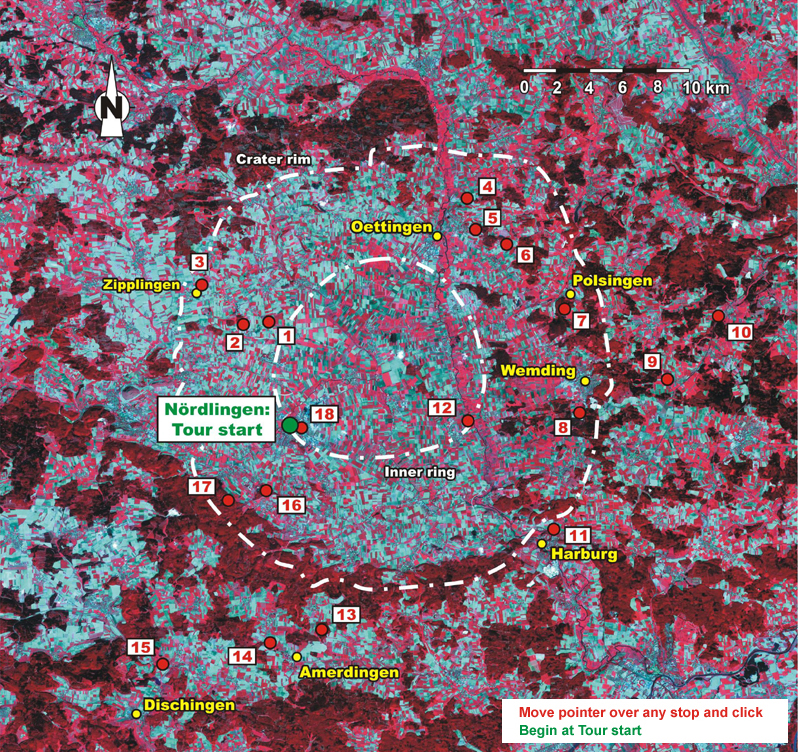
Explorer’s Guide to Impact Craters
Haughton Crater Tour
- Getting to Ries Crater
- Virtual Tour of Ries Crater
- Nördlingen
- Ries Tour – Stop 1
- Ries Tour – Stop 2
- Ries Tour – Stop 3
- Ries Tour – Stop 4
- Ries Tour – Stop 5
- Ries Tour – Stop 6
- Ries Tour – Stop 7
- Ries Tour – Stop 8
- Ries Tour – Stop 9
- Ries Tour – Stop 10
- Ries Tour – Stop 11
- Ries Tour – Stop 12
- Ries Tour – Stop 13
- Ries Tour – Stop 14
- Ries Tour – Stop 15
- Ries Tour – Stop 16
- Ries Tour – Stop 17
- Ries Tour – Stop 18
Stop 10 at Ries

Active quarry at Gundelsheim
Photo: G. Osinski, University of Western Ontario
Location: 7.5 kilometers east-northeast of the east crater rim
Scale: Distance from left to right is approximately 1 kilometer
Gundelsheim is an active Malm limestone quarry and most of the limestone is used as building stone. This quarry is one of the best places around the Ries structure to study the contact between the Bunte Breccia and underlying bedrock of nicely layered, almost flat-lying Malm limestone.
| Geologist Gordon Osinski talks about the geology of Gundelsheim quarry High resolution WMV (12.6 Mb) MP4 (5 Mb) Moderate resolution WMV (6.1 Mb) MP4 (5 Mb) Low resolution WMV (950 Kb) MP4 (5 Mb) |

Bunte Breccia overlying Malm Limestone
Photo: G. Osinski, University of Western Ontario
Location: 7.5 kilometers east-northeast of the east crater rim
Scale: Height of the cliff is 7 meters
The underlying bedrock represents the target rocks that were at or near the surface at the time of impact. Above these limestones we can see about 7 meters of Bunte Breccia. As we saw at Aumühle (stop 4), the Bunte Breccia contains fragments and blocks up to several meters across of sedimentary rocks with some very minor crystalline material (granites and gneisses), but no impact glass. Do you notice anything different between the Bunte Breccia here and that at Aumühle?
Answer: The Bunte Breccia at Gundelsheim consists mostly of yellow-white Malm limestone. At Aumühle, the Bunte Breccia was made up of mainly purple-brown sandstone and shales. This is an important characteristic of the Bunte Breccia. As we discussed at Aum ü hle, much of the Bunte Breccia consists of so-called “secondary ejecta“, which represents the material that was at the surface at the time of impact. At Aum ühle, sandstones and shales were present at the surface, whereas limestone was present at Gundelsheim, which results in Bunte Breccia with very different properties at different locations around the Ries structure.

Striated limestone surface
Photo: G. Osinski, University of Western Ontario
Location: 7.5 kilometers east-northeast of the east crater rim
Scale: Length of the pencil is 12 centimeters
Here, we can see the actual contact between the Bunte Breccia and the underlying limestone. The top surface of the limestone has striations, lines or grooves that were named Schliff-Fläche by the German scientists who first studied them. These striations demonstrate that after the Bunte Breccia was ejected out of the crater, it was deposited onto the surface and continued to flow for considerable distances. The striations formed as the Bunte Breccia travelled out along the bedrock, scraping the surface clean.
